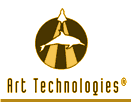IAA-97-IAA.8.2.06
EARTHSTAR : A SPACE ART EUTECTIC
Art Technologies
Beverly Hills, California, USA
48th International Astronautical Congress
October 6-10, 1997 / Turin, Italy
Abstract
EARTHSTAR: A Space Art Eutectic is a multi-faceted space art project that incorporates some new and innovative approaches to the creation of an interdisciplinary artwork. This paper presents a brief overview of the following elements of EARTHSTAR: A Space Art Eutectic.
1. A ceramic artwork created in space that utilizes the transforming process of heat generated during re-entry.
2. The gathering of mineral samples from countries either engaged or recently engaged in armed conflict and used for a eutectic slurry to create the ceramic artifact in space.
3. The site-specific markings on Earth — using Differential GPS (DGPS) — of the 5 vertices of a 6,414 kilometers diameter pentagonal star centered in Crete.
4. SPOT IMAGE satellite imagery of the marker sites for the vertices of the pentagonal star.
5. A cultural arts event in Crete that brings together the countries in armed conflict focusing on World peace and in celebration of the millennium.
6. Participation of UNESCO In the EARTHSTAR project.
Introduction
The idea for EARTHSTAR was conceived in 1996. It began as a fascination with the process of eutectics1 and how heat generated on the surface of a spacecraft during re-entry might be used to create a ceramic artifact from specific samples of earth. In order for this interdisciplinary artwork to have meaning — artistically, philosophically, and technically — the earth samples must bear special significance and a relationship to each other as well as to the eutectic process.
The source of earth samples for the EARTHSTAR space artifact will be obtained from some countries either engaged or recently engaged in armed conflict. The creation of a ceramic artifact in space, utilizing earth samples from these countries, speaks metaphorically about the process of peace. In More Sky, Otto Piene, artist and former Director of the Center for Advanced Visual Studies at MIT states: "Any artifact, however valued, however decorative, is irrelevant to society unless its message is sought after."2
The marking of the vertices of a site-specific pentagonal star on Earth is significant in that the center-point of the pentagram, located in Crete, has rays from the center through each of the vertices extending through regions of armed conflict. The convergence of these rays in Crete and the eutectic artifact formed from mineral samples fused together in space serve as symbols that point to the possibility of a peaceful future. Human beings communicate through art with symbols that transcend the boundaries of time and culture.
Armed Conflict
Project Ploughshares Institute of Peace and Conflict Studies 1996 Armed Conflicts Report states: "In 1995, 44 armed conflicts existed in 39 countries. India, Indonesia, Philippines, Iran, and Iraq were the sites of more than one armed conflict. Children under the age of 15 are being used as soldiers in almost two-thirds of these armed conflicts. These armed conflicts occurred in five broad regions: Africa, the Middle East, Asia, Europe, and The Americas."3
Based on the above information, the selection for EARTHSTAR of candidate countries involved or recently involved in armed conflict was made in the following manner: A clear acetate overlay was marked with 5 rays each starting at a center-point and radiating out 72 degrees apart. This clear template was then moved about over the surface of a map of the World. The objective was to have each ray extending through or touching countries engaged in armed conflict. As it turned out, starting with a ray that intersects Northern Ireland, there was only one placement of the acetate overlay that met that criteria and, interestingly, the center-point fell on Crete.
With the first vertex of the pentagonal star in Northern Ireland, the ray from the center-point in Crete touches Bosnia-Herzegovina. The second vertex (clock-wise) is in Russia with the ray starting at the center-point and passing through Turkey. The third vertex is in Oman with the ray, starting at the center-point, passing through Israel and beyond the vertex passing through India and Sri Lanka. The fourth vertex is in the Central African Republic with the ray starting at the center-point, passing through Sudan, all the way down through South Africa. The fifth vertex is in Mali with the ray starting at the center-point and passing through Algeria (Fig.1). The vertices of the pentagonal star do not necessarily fall on countries of armed conflict.
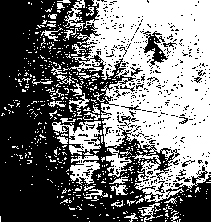
Fig. 1. Globe of Earth marked with the location of vertices, rays, and center-point of EARTHSTAR. Vertices are in Northern Ireland, Russia, Oman, Central African Republic, and Mali. (Photo: John L. Fox II)
Ceramic Artifact
EARTHSTAR will create a ceramic artifact in space using mineral samples collected from selected sites in countries that are either engaged or recently engaged in armed conflict. The Silica-rich mineral samples will be refined and then formulated into a eutectic slurry that will be applied in the shape of a pentagonal star onto one of the thermal protective tiles of a recoverable spacecraft. During re-entry, this thermal protective tile, depending upon its location on the spacecraft, will reach temperatures ranging from 2000-3000 degrees Fahrenheit, in essence "firing" the ceramic EARTHSTAR. The eutectic slurry used for the ceramic artifact will be formulated to vitrify in the upper operating temperature range-determined by its location on the spacecraft-of the specified tile.
A similar technique is used on the U.S. Space Shuttle in repairing Thermal Protection System (TPS) tiles that have sustained damage. If the degree of damage is within the specified tolerances4 and the tile does not have to be replaced, the damaged area is filled with a ceramic slurry that then becomes "fired" during the next re-entry.
The abstract for an experiment carried out on the Thermal Protection System TPS of a Russian FOTON-8 describes the following: "The DLR Stuttgart manufactured two flat disk-like samples of non-ablative heat protection material. These were integrated into the ablative heat protection system of FOTON-8 by KB FOTON. After the mission and re-entry of the capsule, the samples, which were positioned near the stagnation point of the capsule and thus exposed to the maximum heat load, were deintegrated and analyzed afterwards. No damage or essential changes of the samples could be detected. Thus the German material was successfully exposed to a real re-entry for the first time. We want to point out that the material remained absolutely stable at the contact area with the ablative Russian material. This proves the compatibility between the different materials and demonstrates that the integration of the ceramic tile to the nose of the EXPRESS capsule is possible and not too risky."5
A certain poetic quality exists in the eutectic process where the melting point is lower for the combined ingredients than that of any of the individual ingredients. An analogy may be made to the process of peace: in order for peace to occur, a "political eutectic" of sorts must be facilitated.
In "The Artist as Space Explorer as Documented in the Art Journal Leonardo" Roger Malina, Astrophysicist and Executive Editor of Leonardo states: "We as a species, must want to go into space as part of the solution to Earth's problems as well as an opportunity for discovery and exploration."6
Creating interdisciplinary art that is meaningful, using space technology, presents a challenge. The technological and philosophical aspects of the work must be in balance. EARTHSTAR addresses the issues of life and death political situations on Earth and the process of peace. EARTHSTAR is a project that looks towards the future, a future of possibilities that includes a culture of peace with the participation and contribution of many countries of the World that are engaged in armed conflict. In this symbolic "bonding of heaven, Earth, and humankind,"7 the power of critical art can change the way we view the World.
The Golden Section
The symbol for the space artifact created during re-entry is an important consideration. It must have a universal appeal and not be subject to controversy within the countries involved with EARTHSTAR. This symbol will also be used for a site-specific mark on Earth.
The pentagonal star was chosen for the special mathematical properties inherent in its shape (Fig. 2). These properties, referred to sometimes as the "Golden Section," "Golden Ratio," "Golden Triangle" and "Divine Proportion," are found both in art and in nature. Two examples of the many places where these ratios occur are: the Parthenon in Athens, Greece, (Fig. 3) and the Chambered Nautilus shell (Fig. 4). The "Golden Triangle" (isosceles triangle) base angles are 72 degrees and apex angle 36 degrees and are found in the pentagram or triple triangle. The "Golden Triangle" also occurs in the logarithmic spiral (Fig. 5).
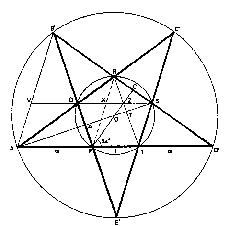
Fig. 2. Pentagram or triple triangle. A rich source
of golden ratios, the pentagram was used as a
symbol and badge of the Society of Pythagoras.8
The "Golden Ratio" is: 1:1.6180339. The numeric value in mathematics is call phi and is represented by the Greek letter ![]() phi. Kepler stated: "Geometry has two great treasures: one is the theorem of Pythagoras; the other, the division of a line into extreme and mean ratio. The first we may compare to a measure of gold; the second we may name a precious jewel."9 This dividing of a line into "extreme and mean ratio" was called "the divine proportion" by Kepler. The thought-provoking relationship between geometry and aesthetics is explored in The Divine Proportion: A Study in Mathematical Beauty by H.E. Huntley. In it Huntley states: "It is to the emotionally charged experiences of a thousand generations of our ancestors that we must look in order to discover the sources of aesthetic pleasure in art, in poetry, in music, in mathematics, and in other artistic forms. It is not impossible to guess what some of these experiences must be which, either because their repetition is so frequent or because they evoke strong mental excitement, have left their indelible traces on our mental structures; these traces are a fixed part of our human inheritance and the ground of our aesthetic appreciation."10
phi. Kepler stated: "Geometry has two great treasures: one is the theorem of Pythagoras; the other, the division of a line into extreme and mean ratio. The first we may compare to a measure of gold; the second we may name a precious jewel."9 This dividing of a line into "extreme and mean ratio" was called "the divine proportion" by Kepler. The thought-provoking relationship between geometry and aesthetics is explored in The Divine Proportion: A Study in Mathematical Beauty by H.E. Huntley. In it Huntley states: "It is to the emotionally charged experiences of a thousand generations of our ancestors that we must look in order to discover the sources of aesthetic pleasure in art, in poetry, in music, in mathematics, and in other artistic forms. It is not impossible to guess what some of these experiences must be which, either because their repetition is so frequent or because they evoke strong mental excitement, have left their indelible traces on our mental structures; these traces are a fixed part of our human inheritance and the ground of our aesthetic appreciation."10
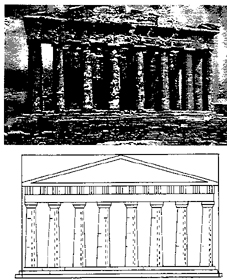
Fig. 3. The Parthenon at Athens, built in the fifth century B.C., one of the World's most famous structures. While its triangular pediment was still intact, its dimensions could be fitted almost exactly in a Golden Rectangle, as shown above. It stands therefore as another example of the aesthetic value of this particular shape.11
The Differential GPS
The sites of selected countries involved in armed conflicts on Earth — used for the collection of mineral samples — will be laid out along five rays 72 degrees apart that start at the center of a pentagonal star and extend out through each vertex. From the center-point of the star, located in Crete, a circle with a radius of 3,207 kilometers intersects each of the star's five vertices. Differential GPS (DGPS) will be used for the location of these vertices. A marker will be placed on Earth at the site of each of the vertices.
DGPS offers a more precise accuracy than GPS by utilization of a reference receiver operating at a known location. The differential corrections provided by the reference receiver result in accuracies down to sub-meter depending upon the type of the GPS receiver.
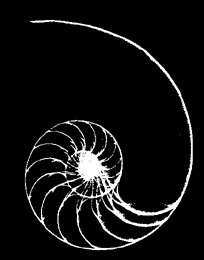 Fig. 4. Radiograph of the shell of the chambered
nautilus (Nautilus pompilius), a beautiful and well-
known modern sea shell. The successive chambers of
the nautilus are built on a framework of a logarithmic
spiral. As the shell grows, the size of the chambers
increases but their shape remains unaltered (courtesy Kodak
Limited London).12
Fig. 4. Radiograph of the shell of the chambered
nautilus (Nautilus pompilius), a beautiful and well-
known modern sea shell. The successive chambers of
the nautilus are built on a framework of a logarithmic
spiral. As the shell grows, the size of the chambers
increases but their shape remains unaltered (courtesy Kodak
Limited London).12
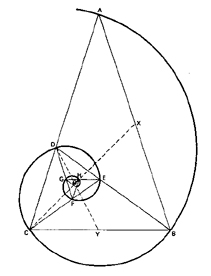
Fig. 5. Logarithmic spiral and golden triangles. In the growth of the mollusk's shell the shape remains the same as the size of the shell increases. (See Fig. 4.)13
Spot Images
After the markers for the vertices are in place, images from space of the marker sites will be provided using SPOT IMAGE14 satellite high-resolution panchromatic data. The SPOT images from space provide the perspective from where the eutectic EARTHSTAR space artifact was created. Describing the vertices for EARTHSTAR only in degrees of latitude, longitude, and dots on a map, does not have the same kind of meaning and impact that a visual image provides. SPOT images make the location of the vertices of the pentagonal EARTHSTAR real. This is visual art. The artist's mission is to communicate through visual imagery. Satellite imagery, the use of Differential GPS, and the eutectic artifact created in space all relate in spirit and meaning to the peaceful use of outer space.
Cultural Event
Upon the spacecraft's return to Earth, the tile bearing the ceramic artifact formed in space will be removed for exhibition at the EARTHSTAR cultural arts event in Crete. It is possible that a suitable historical site on Crete may be found for permanent installation of this space-formed ceramic artifact.
The cultural event — in celebration of peace and the millennium — will feature art, music, and dance of the diverse cultures of the countries engaged in armed conflict. The participation of these countries located on the EARTHSTAR's five rays of convergence presents a powerful and meaningful message of peace to the World.
UNESCO
The author is seeking an endorsement and the participation of UNESCO in the EARTHSTAR project. In 1994, UNESCO created the Culture of Peace Programme (CPP). "The objective of the Culture of Peace Programme is to ensure that the conflicts inherent in human relationships be resolved non-violently, based on the traditional values of peace."15 CPP recognizes the importance of non-governmental organizations (NGOs) and the role that they play in focusing attention and action on all levels: regional, national, and international.
"CPP undertakes and collaborates on a broad range of activities which promote a culture of peace on a global level through UNESCO's fields of competence. These may include:
- development of materials emanating from projects like the sub-regional Culture of Peace festivals for primary schoolchildren (in conjunction with the UNESCO Associated Schools Project)
- new educational projects such as support for conflict resolution in schools located in violent areas of major cities, and the preparation of appropriate educational materials
- forum meetings of intellectuals, opinion shapers and representatives of various sectors of society
- projects which support positive cultural images in the arts and media
- projects to address the problem of violence in the media while respecting feelings of repression
Through these activities and others, CPP works to develop and enlarge this worldwide coalition for a culture of peace and to assist in the long-term conversion from the existing culture of violence to a culture more amenable to peace, social justice, tolerance and democracy."16
A good opportunity exists for the people who live in the countries along the rays of EARTHSTAR to contribute by helping to gather mineral samples and locating and installing the markers for the 5 vertices. This involvement and participation of individuals from underdeveloped countries who may lack access to the opportunities of space brings to attention the potential of space in seeking solutions to Earth-bound problems.
The divine beauty
Of heaven and earth!
All creation,
Members of,
One Family17
References & Notes
1. eutectic (yoo tek’ tik) adj. [ < Gr. eutekos, easily fused < eu-, well + tekein, to melt + -IC] fusing at the lowest possible temperature; specif., designating or of a mixture or alloy with a melting point lower than that of any other combination of the same components -- n. a eutectic mixture or alloy -- eu tec’ toid adj.,
2. Otto Piene, More Sky (Cambridge, Mass., and London, England: The MIT Press,) 1970 p.13.
3. 1996 Armed Conflicts Report (Waterloo, Ontario: Conrad Grebel College, Project Ploughshares Institute of Peace and Conflicts Studies (1996) p.3
4. K.A. Hinkle and K.R. Raval, Material Specification MB 0115-049 (Palmdale, California: Rockwell Int.,) 1996 p.3.
5. Kemmerle, K. (Kayser Threde G.m.b.H.) Hald, H. (Kayser Threde G.m.b.H.) Test of C/SiC-fibre ceramic thermal protection samples under real re-entry conditions on FOTON. Document ID: 19960042705 N (96N72374) May 27, 1993
6. Roger F. Malina, The Artist As Space Explorer As Documented In The Art Journal Leonardo IAA-95-IAA.8.2.01 (Oslo, Norway: 46th International Astronautical Congress) 1995, p. 3.
7. Morihei Ueshiba, The Art Of Peace, translated by John Stevens (Boston & London: Shambhala, 1987) p. 20.
8. Reproduced with permission, H.E. Huntley, The Divine Proportion: a Study in Mathematical Beauty (New York: Dover Publications, Inc., 1970) p. 28.
9. See Huntley [8] p. 23.
10. See Huntley [8] p. 79
11. See Huntley [8] p. 63
12. See Huntley [8] frontispiece
13. See Huntley [8] p. 171
14. SPOT IMAGE, rue des satellites, BP4359,
F31030, Toulouse, France
15. UNESCO Culture of Peace Programme, (San Salvador: International Forum on the Culture of Peace), February 1994 p.1.
16. See UNESCO [15] p.2.
17. See Ueshiba [7] p.10.
